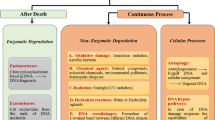Abstract
It has been amply demonstrated that DNA can persist in dried biological materials for many years, in some cases decades and centuries. The secret to this persistence is the absence of bulk water in such materials, for the most damaging mechanisms of DNA deterioration require water either as a reactant or as a medium. In the absence of water, the rates of microbial growth, enzymatic degradation, spontaneous hydrolysis, and other forms of chemical damage are greatly slowed.
Access this chapter
Tax calculation will be finalised at checkout
Purchases are for personal use only
Preview
Unable to display preview. Download preview PDF.
Similar content being viewed by others
References
Aasen E, Medrano JF (1990) Amplification of the ZFY and ZFX genes for sex identification in humans, cattle, sheep, and goats. Biotechnology 8:1279–1281
Buoncristiani M, von Beroldingen C, Sensabaugh GF (1990) Effects of UV damage on DNA amplification by the polymerase chain reaction. In: Polesky HF, Mayr WR (eds) Advances in Forensic Haemogenetics, vol 3. Berlin: Springer-Verlag, pp. 151–153
Friedberg EC (1985) DNA Repair. New York: WH Freeman
Gill P, Jeffreys J, Werrett D (1985) Forensic application of DNA fingerprints. Nature 318:577–579
Higuchi R, von Beroldingen C, Sensabaugh GF, Erlich H (1988) DNA typing from single hairs. Nature 332:543–546
Igo-Kemenes T, Horz W, Zachau HG (1982) Chromatin. Annu Rev Biochem 51:89–121
Irwin D, Kocher TD, Wilson AC (1991) Evolution of the cytochrome b gene in mammals. J Mol Evol 32:128–144
Pääbo S, Gifford JA, Wilson AC (1988) Mitochondrial DNA sequences from a 7000 year old brain. Nucl Acids Res 16:9775–9787
Reynolds R, Sensabaugh GF, Blake ET (1991) Analysis of genetic markers in forensic DNA samples using the polymerase chain reaction. Anal Chem 63:2–15
Sambrook J, Fritsch EF, Maniatis T (1989) Molecular Cloning. A Laboratory Manual. 2nd ed. Cold Spring Harbor, N.Y.: CSHL Press
Sensabaugh GF, von Beroldingen C (1971) Genetic typing of biological evidence using the polymerase chain reaction. In: Farley MA, Harrington JJ (eds) Forensic DNA Technology. Chelsea, Mich.: Lewis Publishers. pp. 63–82
Walsh PS, Metzger DA, Higuchi R (1991) Chelex 100 as a medium for simple extraction of DNA for PCB-based typing from forensic material. Biotechniques 10:506–513
Ward WS, Coffey DS (1991) DNA packaging and organization in mammalian spermatozoa: comparison with somatic cells. Biol Reprod 44:569–574
Weye JS, Prestley LA, Budowle B, Shutler GG, Fourney RM (1989) A simple and sensitive method for quantifying human genomic DNA in forensic specimen extracts. Biotechniques 8:852–855
Witt M, Erickson RP (1989) A rapid method for detection of Y-chromosomal DNA from dried blood specimens by the polymerase chain reaction. Human Genetics 82:271–274
Editor information
Editors and Affiliations
Rights and permissions
Copyright information
© 1994 Springer-Verlag New York Inc.
About this chapter
Cite this chapter
Sensabaugh, G.F. (1994). DNA Typing of Biological Evidence Material. In: Herrmann, B., Hummel, S. (eds) Ancient DNA. Springer, New York, NY. https://doi.org/10.1007/978-1-4612-4318-2_9
Download citation
DOI: https://doi.org/10.1007/978-1-4612-4318-2_9
Publisher Name: Springer, New York, NY
Print ISBN: 978-0-387-94308-4
Online ISBN: 978-1-4612-4318-2
eBook Packages: Springer Book Archive




